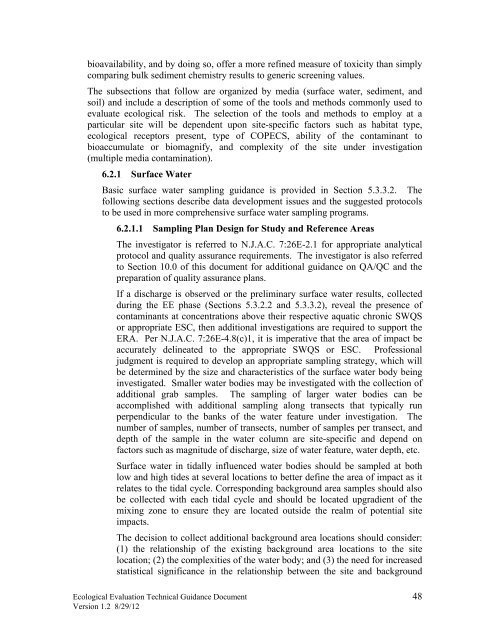Ecological Evaluation Technical Guidance - State of New Jersey
Ecological Evaluation Technical Guidance - State of New Jersey
Ecological Evaluation Technical Guidance - State of New Jersey
- No tags were found...
You also want an ePaper? Increase the reach of your titles
YUMPU automatically turns print PDFs into web optimized ePapers that Google loves.
ioavailability, and by doing so, <strong>of</strong>fer a more refined measure <strong>of</strong> toxicity than simplycomparing bulk sediment chemistry results to generic screening values.The subsections that follow are organized by media (surface water, sediment, andsoil) and include a description <strong>of</strong> some <strong>of</strong> the tools and methods commonly used toevaluate ecological risk. The selection <strong>of</strong> the tools and methods to employ at aparticular site will be dependent upon site-specific factors such as habitat type,ecological receptors present, type <strong>of</strong> COPECS, ability <strong>of</strong> the contaminant tobioaccumulate or biomagnify, and complexity <strong>of</strong> the site under investigation(multiple media contamination).6.2.1 Surface WaterBasic surface water sampling guidance is provided in Section 5.3.3.2. Thefollowing sections describe data development issues and the suggested protocolsto be used in more comprehensive surface water sampling programs.6.2.1.1 Sampling Plan Design for Study and Reference AreasThe investigator is referred to N.J.A.C. 7:26E-2.1 for appropriate analyticalprotocol and quality assurance requirements. The investigator is also referredto Section 10.0 <strong>of</strong> this document for additional guidance on QA/QC and thepreparation <strong>of</strong> quality assurance plans.If a discharge is observed or the preliminary surface water results, collectedduring the EE phase (Sections 5.3.2.2 and 5.3.3.2), reveal the presence <strong>of</strong>contaminants at concentrations above their respective aquatic chronic SWQSor appropriate ESC, then additional investigations are required to support theERA. Per N.J.A.C. 7:26E-4.8(c)1, it is imperative that the area <strong>of</strong> impact beaccurately delineated to the appropriate SWQS or ESC. Pr<strong>of</strong>essionaljudgment is required to develop an appropriate sampling strategy, which willbe determined by the size and characteristics <strong>of</strong> the surface water body beinginvestigated. Smaller water bodies may be investigated with the collection <strong>of</strong>additional grab samples. The sampling <strong>of</strong> larger water bodies can beaccomplished with additional sampling along transects that typically runperpendicular to the banks <strong>of</strong> the water feature under investigation. Thenumber <strong>of</strong> samples, number <strong>of</strong> transects, number <strong>of</strong> samples per transect, anddepth <strong>of</strong> the sample in the water column are site-specific and depend onfactors such as magnitude <strong>of</strong> discharge, size <strong>of</strong> water feature, water depth, etc.Surface water in tidally influenced water bodies should be sampled at bothlow and high tides at several locations to better define the area <strong>of</strong> impact as itrelates to the tidal cycle. Corresponding background area samples should alsobe collected with each tidal cycle and should be located upgradient <strong>of</strong> themixing zone to ensure they are located outside the realm <strong>of</strong> potential siteimpacts.The decision to collect additional background area locations should consider:(1) the relationship <strong>of</strong> the existing background area locations to the sitelocation; (2) the complexities <strong>of</strong> the water body; and (3) the need for increasedstatistical significance in the relationship between the site and background<strong>Ecological</strong> <strong>Evaluation</strong> <strong>Technical</strong> <strong>Guidance</strong> Document 48Version 1.2 8/29/12
















